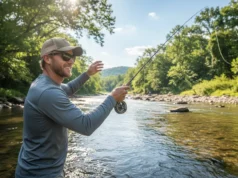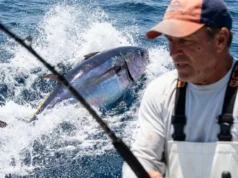In this article
The last sliver of sun dipping below the horizon, the water turning to glass. Then, a subtle tap-tap—a signal so faint you might miss it. This is the world of the Walleye, a prized game fish defined by the low-light edges of the day. Success in walleye fishing doesn’t just come from the right lure; it comes from understanding the biological secrets that drive this elusive fish. This guide provides those secrets, transforming you from a hopeful caster into a calculated hunter by decoding the essential facts that dictate Walleye behavior from spawning to strike.
This journey will take us deep into the Walleye’s world. We’ll start by building its Biological Blueprint, uncovering the unique anatomy behind its famous eyes and how its body is engineered for life as an apex predator. From there, we’ll explore its Ecological Context, learning how water temperatures, habitat, and seasonal changes create a predictable annual playbook for where this migratory freshwater fish will be. With that knowledge, we’ll move to Strategic Application, discovering how to translate these biological facts into more effective angling tactics. Finally, we’ll embrace the Conservation Imperative, understanding the modern threats facing the walleye population and how our informed angling practices contribute to their long-term health.
What Defines a Walleye? The Biological Blueprint
To truly understand an animal, you have to start with its fundamental design. This section establishes the foundational walleye biology, focusing on the physical and sensory traits that make this popular species a unique and successful predator.
What are a Walleye’s Key Physical and Taxonomic Features?
The Walleye (Sander vitreus) is a freshwater perciform fish and the largest member of the Perch family (Percidae) in North America, a distinction that cements its role as a top predator in the food chain. It possesses a streamlined, long and thin, torpedo-shaped powerful body built for efficient pursuit. Its coloration is functional camouflage; the olive and gold color on its back, often crossed with five or more dark bands, fades to brassy flecks on the flanks and a white belly. The state fish of Minnesota, South Dakota, and Vermont, it is prized by anglers not only because it can be tricky to catch, but also for its famously mild flavor and flaky white fillets.
Its most telling features are in the fins. Two dorsal fins are a primary identifier: the anterior spiny dorsal fin is formidable, while the posterior is a soft-rayed fin. Critically, a prominent white-tipped caudal fin distinguishes it from its close relative, the sauger. These sharp fins are a key trait for any angler to learn.
Of course, a predator is defined by its weaponry. The Walleye’s large mouth is armed with many sharp teeth, all designed for grasping and disabling prey. While the Walleye averages 1 to 2 pounds in most waters, it has continuous growth and can reach a staggering 10-20 pounds. Walleye are about 2.5 to 3 feet (0.75 to 0.9 meters) in length, with a maximum recorded length of 42 inches. They have a long lifespan, with a maximum recorded age of 29 years, though an average of 10-20 years is more typical. A key management fact is that males reach maturity age between 3-4 years, while females mature about a year later and grow to much larger sizes. For authoritative data, the U.S. Fish & Wildlife Service species profile on Walleye (Sander vitreus) is an excellent resource. These facts are the first step in connecting biology to the art of angling, a topic we explore in our comprehensive beginner’s guide to Walleye fishing.
With its physical form established, we now turn to the one feature that dictates its entire existence.
How Does a Walleye’s Vision Grant a Predatory Advantage?
The famous “eyeshine” of a Walleye is more than a quirky feature; it is the biological engine driving its entire life strategy. Its protruding eyes, which give it a “wall-eyed” appearance, contain a specialized reflective layer behind the retina called the tapetum lucidum. When light passes through the retina, any unabsorbed photons strike this layer and are reflected back for a second pass. This process dramatically increases available light, granting the fish superior low-light vision. It is the same system found in nocturnal animals, giving them a profound advantage in the dark, and it results in the signature pearlescent eyes or opaque eye glow.
This adaptation is the central axis of the Walleye’s ecological niche. It allows them to hunt with lethal efficiency when their prey are visually impaired. The famous Walleye tendency to avoid bright light is an evolutionarily-honed strategy to exploit this sensory advantage. They feed in low light, which is why feeding occurs primarily at dawn and dusk. This nocturnal behavior begins early in young walleyes. You can explore a Minnesota DNR’s biological overview for more expert detail on this incredible adaptation.
Pro-Tip: A Walleye’s light-gathering eyes are less effective at distinguishing fine color detail in the dark. Instead of worrying about the perfect color, focus on lure profiles that match local forage and actions that create vibration and water displacement. In low light or stained water, lures with flashy colors that offer high contrast, like black, white, or chartreuse, often outperform subtle, natural patterns.
This powerful sensory weapon is deployed within a finely tuned life cycle, dictated by the rhythm of the seasons.
Where Does a Walleye Fit in its World? The Ecological Context
A fish is a product of its environment. This section places the Walleye within its natural world, explaining how its life is governed by habitat, diet, and the predictable cycle of seasons.
What is the Walleye’s Reproductive Strategy and Life Cycle?
Walleye reproduction is a marvel of natural timing. The walleye spawn is initiated by environmental cues in the spring or early summer, typically April-May. Rising water temperatures signal that it’s time, with peak activity occurring in a critical 40-50°F water window. This triggers a mass migration to specific spawning grounds. They seek shallow areas with gravelly rocky bottoms, exposed to current or windswept wave action, which is vital for oxygenating the eggs.
The ritual itself occurs at night. A single female can deposit more than 100,000+ eggs, which are fertilized and stick to the substrate. Incubation is temperature-dependent, lasting about 2-3 weeks. The newly hatched fry subsist on a yolk sac before they must begin feeding on microscopic zooplankton.
This is a high-risk strategy. Zero parental care makes the success of a walleye year-class extremely sensitive to environmental conditions. A sudden cold snap can lead to mass starvation. Modern research shows that climate change is causing a dangerous “mismatch” between historical ice-out dates and the Walleye’s spawning instinct, threatening the species. This seasonal drive is a powerful force, and you’ll find it’s remarkably similar to the spring bass spawn, reinforcing a broader concept of seasonal behavior.
The survival of these new generations depends entirely on finding the right home.
What is the Walleye’s Preferred Habitat and Native Range?
Walleye are classified as a species that prefers cool, deep, quiet waters. Their optimal habitat includes large rivers, lakes, reservoirs, and streams. While they can live in clear water, they thrive in turbid water where their vision provides a distinct advantage. Their behavior follows a pattern of holding in deeper water during the day and moving to shallower water at night to feed. They often travel in schools, a key fact for anglers to remember.
The native range of the Walleye covers a vast portion of North America, including Canada, the Great Lakes like Lake Erie, the Upper Mississippi River basin, and the Missouri River basin. Popularity in sport fishing has led to its wide introduction into the western United States and northeastern United States. The construction of reservoirs has created new, stable habitats where walleye populations can thrive. You can view this expansion on the definitive USGS species distribution maps. Understanding this habitat is the first step in learning how to find the perfect fishing spot.
Within these habitats, the Walleye’s daily life follows a predictable rhythm driven by the hunt.
How Do Anglers Translate Biology into Success? The Strategic Edge
This is where knowledge becomes action. This section bridges the gap between biological facts and practical, sustainable angling by explaining how Walleye biology directly informs strategy, tactics, and conservation ethics.
How Do Seasonal Changes and Daily Patterns Dictate Walleye Behavior?
The key to consistently finding Walleye is understanding their role as a “Bentho-Pelagic Commuter.” This means they exhibit a predictable daily migration. They use the deep, dark bottom zone for security and migrate to shallower zones to feed. This daily commute is the foundation, but it changes dramatically with the seasons.
Seasonal Walleye Location & Behavior Guide
A comprehensive table to help anglers find and catch walleye year-round.
Location & Behavior
Migrating towards shallow, current-swept spawning areas like rocky points, river mouths, and gravel flats.
Techniques
Jigging with soft plastics or live bait, slow-trolling crankbaits.
Location & Behavior
Main-lake structures like deep weedlines, humps, and points during the day. Move to adjacent shallow flats at night.
Techniques
Bottom bouncing with crawler harnesses, deep-diving crankbaits, slip bobbers.
Location & Behavior
Moving from deep summer haunts back towards shallower structures where baitfish congregate.
Techniques
Aggressive jigging with larger baits, trolling crankbaits, casting swimbaits.
Location & Behavior
Deep, stable basins and sharp drop-offs on main-lake structure.
Techniques
Vertical jigging for ice fishing, using spoons or jigs tipped with minnow heads.
As carnivorous hunters, their diet includes small fish, large invertebrates, insects, leeches, snails, frogs, and crayfish. They are particularly active in choppy/windy conditions, which creates the famous “walleye chop.” A falling barometer ahead of a storm often initiates aggressive feeding. This science behind seasonal regulations is well-documented by sources like NOAA Fisheries on sustainable management, and the summer patterns fit into our complete system for summer fishing.
Understanding this predictable cycle is the first step; the next is learning how to protect the resource you pursue.
What Are the Primary Threats and Conservation Strategies for Walleye?
Modern Walleye populations face a suite of threats, including water quality degradation, habitat loss from channelization and erosion, climate change, and overfishing. A key angling-related threat is barotrauma. When a Walleye is brought up rapidly from deep water (>30 feet), the gases in its swim bladder expand, causing fatal injuries. This is a critical consideration for catch-and-release angling.
Fisheries management agencies use science-based tools to counteract these threats. But anglers are the front line of conservation. Sustainable angling practices are critical. This includes using tackle matched to the fish, using barbless hooks, and minimizing air exposure. When releasing a fish with barotrauma, the best practice is to use a descending device—a weighted clip that returns the fish to depth, allowing its swim bladder to recompress naturally.
Pro-Tip: Proper fish handling is as important as the release itself. Always wet your hands before touching a fish to protect its sensitive slime coat. Use a rubberized net to prevent injury and fin damage. Support the fish’s weight horizontally with both hands, never vertically by the jaw, which can damage its internal organs.
Finally, a core angler responsibility is following the “Clean, Drain, Dry” protocol on all boats and gear to prevent the spread of invasive species. For a top-tier look at conservation, review the provincial best practices for fish handling from Ontario, a leader in Walleye management. These principles are part of the science of catch and release that applies to all species.
With a full understanding of the Walleye’s biology, ecology, and the challenges it faces, we can distill these complex facts into a final set of actionable takeaways.
Conclusion
The story of the Walleye is one of masterful adaptation. Its entire life strategy—from its torpedo-shaped body to its nocturnal hunting patterns—revolves around its superior low-light vision, granted by the tapetum lucidum. We’ve learned that Walleye are native to the Great Lakes and Mississippi basin, and their populations are governed by a high-risk reproductive strategy tied to a critical spring temperature window of 42-50°F. For the angler, success depends on intercepting their predictable migrations, especially at dawn and dusk. And as stewards, we know that sustainable angling requires a deep understanding of biological facts, especially when practicing catch-and-release.
Use these facts not just to catch more Walleye, but to become a more informed steward of the resource. Appreciate the intricate biology that leads to that subtle tap-tap in the twilight. Explore our full library of species guides to continue turning science into success.
Frequently Asked Questions about Walleye Biology and Behavior
What is a walleye fish?
The Walleye (Sander vitreus) is a freshwater fish and the largest member of the Perch family in North America. It is a popular game fish, known for its elusive nature and excellent taste, and is easily identified by its opaque, pearlescent eyes and a white tip on the lower part of its tail fin.
How big do walleye get?
While the average Walleye caught is between 1 and 3 pounds, they can grow much larger, with the world record at 25 pounds. A typical large walleye is about 2.5 to 3 feet long, with a maximum recorded length of 42 inches. Any fish over 10 pounds is generally considered a trophy.
What do walleye eat?
Adult walleyes are primarily piscivorous, eating other fish like yellow perch, shiners, and ciscoes. Their diet progresses with age, starting with zooplankton as fry and moving to insects and invertebrates like crayfish, leeches, and minnows as juvenile walleyes.
Where do walleye live?
Walleye are native to the cool, deep lakes and large rivers of central North America, particularly the Great Lakes and Mississippi River basins. They are highly adaptable and have been widely stocked across the United States, often thriving in large man-made reservoirs.
Risk Disclaimer: Fishing, boating, and all related outdoor activities involve inherent risks that can lead to injury. The information provided on Master Fishing Mag is for educational and informational purposes only. While we strive for accuracy, the information, techniques, and advice on gear and safety are not a substitute for your own best judgment, local knowledge, and adherence to official regulations. Fishing regulations, including seasons, size limits, and species restrictions, change frequently and vary by location. Always consult the latest official regulations from your local fish and wildlife agency before heading out. Proper handling of hooks, knives, and other sharp equipment is essential for safety. Furthermore, be aware of local fish consumption advisories. By using this website, you agree that you are solely responsible for your own safety and for complying with all applicable laws. Any reliance you place on our content is strictly at your own risk. Master Fishing Mag and its authors will not be held liable for any injury, damage, or loss sustained in connection with the use of the information herein.
Affiliate Disclosure: We are a participant in the Amazon Services LLC Associates Program, an affiliate advertising program designed to provide a means for us to earn advertising fees by advertising and linking to Amazon.com. As an Amazon Associate, we earn from qualifying purchases. We also participate in other affiliate programs and may receive a commission on products purchased through our links, at no extra cost to you. Additional terms are found in the terms of service.





